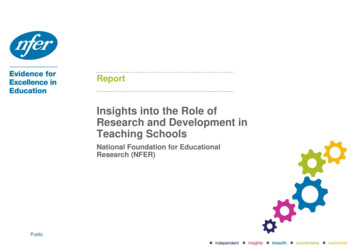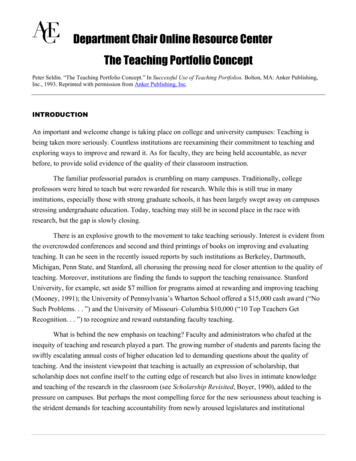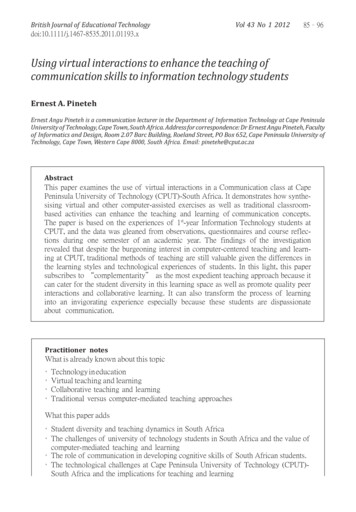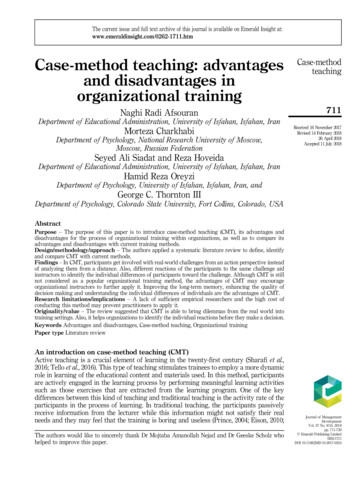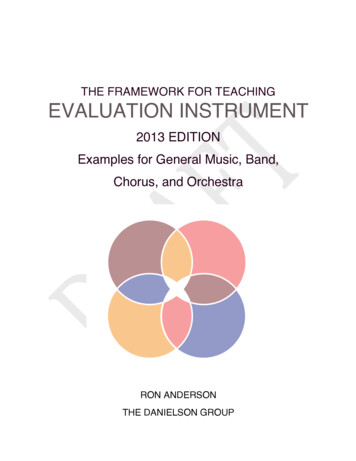
Transcription
The Center for the Future of Teaching and LearningThe Statusof theTeachingProfession2005 FULL REPORTCalifornia State University, Officeof the ChancellorPolicy Analysis for California EducationUniversity of California, Office ofthe PresidentWestEdResearch conducted by SRIInternational
Teaching and California’s Future is sponsored by The Center for the Future of Teaching and Learning. TheCenter is made up of education professionals, scholars and public policy experts who care deeply aboutimproving the schooling of California’s children. The Center was founded in 1995 as a public, nonprofitorganization with the purpose of strengthening the capacity of California’s teachers for delivering rigorous,well-rounded curriculum and ensuring the continuing intellectual, ethical and social development of allchildren.This report was produced by The Center for the Future of Teaching and Learning in consultation with ourco-sponsors — California State University, Office of the Chancellor; Policy Analysis for CaliforniaEducation; University of California, Office of the President; and WestEd.Research was conducted by SRI International of Menlo Park, CA, which had primary responsibility forwriting this report.Funding for this initiative was generously provided by: Clarence E. Heller Charitable FoundationThe William and Flora Hewlett FoundationThe James Irvine FoundationStuart FoundationWashington MutualDesign by KSA-Plus Communications of Arlington, VA.Promotion by Stone’s Throw Communications of Manhattan Beach, CA.Copyright 2005. All rights reserved.The Center for the Future of Teaching and Learning133 Mission Street, Suite 220Santa Cruz, CA 95060www.cftl.org
Teaching and California’s FutureThe Status of the Teaching Profession 2005Full ReportThe Center for the Future of Teaching and LearningandCalifornia State University, Office of the ChancellorPolicy Analysis for California EducationUniversity of California, Office of the PresidentWestEdResearch Conducted by SRI InternationalSuggested citation:Esch, C. E., Chang-Ross, C. M., Guha, R., Humphrey, D. C., Shields, P. M., Tiffany-Morales, J. D.,Wechsler, M. E., and Woodworth, K. R. (2005). The status of the teaching profession 2005.Santa Cruz, CA: The Center for the Future of Teaching and Learning.Copyright 2005. All rights reserved.The Center for the Future of Teaching and Learning 133 Mission Street, Suite 220 Santa Cruz, CA 95060831-427-3628 www.cftl.org
CosponsorsCalifornia State University, Office of the ChancellorThe Center for the Future of Teaching and LearningPolicy Analysis for California EducationUniversity of California, Office of the PresidentWestEdTask Force MembersCo-Chair:Stan Hitomi, Executive DirectorEdward Teller Education CenterLawrence Livermore LaboratoriesCo-Chair:Karl Pister, Chancellor EmeritusUniversity of California, Santa CruzConstance Carroll, ChancellorSan Diego Community CollegeBob Cherry, Associate Executive DirectorCalifornia Teachers AssociationDiane Cordero de NoriegaInterim PresidentCalifornia State University, Monterey BaySandy Dean, DirectorNational Board for Professional Standards ResourceCenter, Stanford UniversityJane Ching Fung, TeacherAlexander Science Center SchoolKen Futernick, Professor of EducationCalifornia State University, SacramentoDave Gordon, SuperintendentSacramento County Office of EducationSusan Hackwood, Executive DirectorCalifornia Council on Science & TechnologyElaine Johnson, ConsultantCalifornia Federation of TeachersDonald Kairott, DirectorProfessional Development & Curriculum SupportCalifornia Department of EducationHarold Levine, DeanSchool of EducationUniversity of California, DavisDouglas Miller, SuperintendentPanama-Buena Vista Union School DistrictJeannie Oakes, Presidential Professor and DirectorInstitute for Democracy, Education, & AccessUniversity of California, Los AngelesScott Plotkin, Executive DirectorCalifornia School Boards AssociationLuan Rivera, President ElectCalifornia School Boards AssociationDiane Siri, SuperintendentSanta Cruz County Office of EducationRichard Sterling, Executive DirectorNational Writing ProjectUniversity of California, BerkeleySusan Stickel, Deputy SuperintendentState Superintendent of Public InstructionWilliam Thompson, TeacherAptos High SchoolArthurlene Towner, DeanSchool of Education and Allied StudiesCalifornia State University, East BayJean Treiman, Executive DirectorCalifornia Subject Matter ProjectsEdward Valeau, PresidentHartnell Community CollegeAida Walqui, DirectorTeacher Professional Development ProgramWestEdBeverly Young, Assistant Vice ChancellorTeacher Education and Public School ProgramsCalifornia State University System
AdvisorsStephen Blake, Chief ConsultantSelect Committee on California’sMaster Plan for EducationDavis Campbell, PresidentGovernance InstituteCalifornia School Boards AssociationLinda Darling-Hammond, Professor of EducationStanford University School of EducationCarolyn Ellner, PresidentOn the Job ParentingJerry Hayward, Director EmeritusPolicy Analysis for California EducationEllen Hershey, Senior Program OfficerStuart FoundationMilbrey McLaughlin, Professor ofEducation and Public PolicyStanford UniversityJohn Mockler, PresidentJohn Mockler and AssociatesBonnie Parks, DirectorGovernmental RelationsCalifornia Commission on Teacher CredentialingMike Ricketts, Chief ConsultantAssembly Education CommitteeRichard Simpson, Deputy Chief of StaffOffice of the Speaker of the AssemblyJames Wilson, Staff DirectorSenate Standing Committee on EducationLinda Bond, Director (Retired)Governmental RelationsCalifornia Commission on Teacher Credentialing
AcknowledgementsThe SRI research team included the following people: Christopher M. Chang-Ross,Camille E. Esch, Roneeta Guha, Heather Hough, Paul Hu, Daniel C. Humphrey,Alejandra Lopez-Torkos, Patrick M. Shields, Juliet D. Tiffany-Morales, Marjorie E. Wechsler,and Katrina R. Woodworth. Editing and production support were provided by Meredith Ittnerand Deborah DuCharme.We would like to thank Steve Burke, Hal Javitz, Julie Koppich, Michael McKibbin, and staff atthe California Department of Education for their assistance.In addition, we would like to extend our appreciation to the district administrators, principals,and teachers in our case study districts for their participation in the study; and the Teaching andCalifornia’s Future Cosponsors, Task Force Members, and Advisors for their insights andsuggestions throughout the development of this report.
Table of ContentsExecutive Summary . vii1. Introduction. 1Teaching and California’s Future . 2Data Collection . 2Organization of the Report. 32. Policy Update. 5Status of State Teacher Development Policies . 5Additional Influences on Teacher Development . 9Conclusion . 123. Teacher Supply and Demand. 15California’s Teacher Workforce . 16Projecting Future Supply and Demand . 17Teacher Demand Factors . 19Teacher Supply Factors. 25Conclusion . 304. Filling the Gap Between Teacher Supply and Demand . 31Authorizations for Underprepared Teachers. 33Changes to Underprepared Teacher Pool . 36Growth of Intern Programs . 37Underprepared Teachers in Different Subject Areas . 40Conclusion . 44The Center for the Future of Teaching and LearningiThe Status of the Teaching Profession 2005
5. Inadequate Preparation for Specific Teaching Assignments. 45Teachers Who Are Not Prepared to Teach English Learners . 46Out-of-Field Teachers. 50Novice Teachers in Challenging Assignments . 56Conclusion . 606. The Distribution of Teachers Across California’s Schools . 61Maldistribution of Teachers Across the State. 63Contributing Factors to Teacher Maldistribution . 77Conclusion . 937. Conclusions and Recommendations. 95Conclusions. 95Recommendations. 96References. 101Appendix ATeacher Development Policies . A-1Appendix BTechnical Information for Selected Exhibits . B-1Appendix CData Collection Methods and Analyses. C-1Appendix DTeacher Assignment Policies. D-1The Center for the Future of Teaching and LearningiiThe Status of the Teaching Profession 2005
ExhibitsExhibit 1Background on Defunct State-Sponsored Recruitment Programs. 7Exhibit 2Funding Levels for Select State Professional Development Programs,2000-01 to 2005-06. 9Exhibit 3California K-12 Teacher Workforce, 1994-95 to 2004-05 . 17Exhibit 4Projected K-12 Public School Teacher Workforce Through 2014-15. 18Exhibit 5Change in K-12 Public School Enrollment, by Grade,2001-02 to 2004-05. 20Exhibit 6Actual and Projected K-12 Public School Enrollment,1990-91 to 2013-14. 21Exhibit 7Age Distribution of K-12 Public School Teachers, 2004-05. 23Exhibit 8STRS Membership Retirements, 1994-95 to 2003-04. 24Exhibit 9New Preliminary Teaching Credentials Issued,1992-93 to 2003-04. 26Exhibit 10New Preliminary Teaching Credentials Issued,by Institution, 2000-01 to 2003-04 . 27Exhibit 11Number of Underprepared Teachers, 1997-98 to 2004-05. 33Exhibit 12NCLB-Compliant Authorizations for Underprepared Teachers. 34Exhibit 13Non-NCLB-Compliant Authorizations for Underprepared Teachers. 35Exhibit 14Number of Underprepared Teachers, by Credential Type,1999-00 to 2004-05. 37Exhibit 15Number of Internship Programs and Program Funding,1994-95 to 2004-05. 38Exhibit 16New University, District, and Individualized Intern Credentials Issued,1991-92 to 2003-04. 39Exhibit 17Percentage of Underprepared Teachers, by Type of Authorization,1999-2000 to 2004-05. 41Exhibit 18Percentage of Underprepared High School Teachers inAssigned Subject, 2004-05 . 42Exhibit 19Percentage of Fully Credentialed Experienced Teacherswith EL Authorization, 1999-2000 to 2004-05. 47Exhibit 20Requirements for Teachers of English Learners. 49Exhibit 21Steps to Correcting an English Learner Misassignment . 49Exhibit 22Percentage of Out-of-Field High School Teachers inCore Subjects, 2004-05. 52Exhibit 23Education Code and Assignment Flexibility . 55The Center for the Future of Teaching and LearningiiiThe Status of the Teaching Profession 2005
Exhibit 24New Teacher Nightmare: Out-of-Field and Remedial Courses. 57Exhibit 25Policies to Ensure that Teacher Assignments are Balanced and Fair . 59Exhibit 26Distribution of Schools, by School-Level Percentage ofUnderprepared Teachers, 2004-05. 63Exhibit 27Distribution of Schools, by School-Level Percentage ofNovice Teachers, 2004-05 . 65Exhibit 28Underprepared Teachers in Schools in the Highest andLowest API Achievement Quartiles, 1999-2000 to 2004-05. 66Exhibit 29Underprepared and Novice Teachers,by API Achievement Quartiles, 2004-05. 67Exhibit 30Underprepared and Novice Teachers, by School-LevelPercentage of 10th-Grade Students Passing CAHSEE Math,2004-05 . 68Exhibit 31Underprepared and Novice Teachers, by School-LevelPercentage of 10th-Grade Students Passing CAHSEE English,2004-05 . 69Exhibit 32Underprepared Teachers in Schools with the Highest andLowest Percentages of Minority Students,1999-2000 to 2004-05. 70Exhibit 33Underprepared and Novice Teachers, by School-LevelPercentage of Minority Students, 2004-05 . 71Exhibit 34Underprepared and Novice Teachers, by School-LevelPercentage of English Learners, 2004-05 . 72Exhibit 35Distribution of Interns, by School-level Percentage ofMinority Students, 2004-05 . 73Exhibit 36Underprepared Special Education Teachers, by School-levelPercentage of Minority Students, 2004-05 . 74Exhibit 37Distribution of Underprepared Teachers with a Math Assignment,by School-level Percentage of Minority Students, 2004-05 . 75Exhibit 38Distribution of Underprepared Teachers with a Science Assignment,by School-level Percentage of Minority Students, 2004-05 . 76Exhibit 39One District’s Efforts to Grow Its Own Teachers . 79Exhibit 40Finding and Recruiting the Right Teachers . 81Exhibit 41Compensation for Experienced Teachers Who Transfer . 879The Center for the Future of Teaching and LearningivThe Status of the Teaching Profession 2005
The Center for the Future of Teaching and LearningvThe Status of the Teaching Profession 2005
The Center for the Future of Teaching and LearningviThe Status of the Teaching Profession 2005
Executive SummaryFor over a decade, Californians have had to face the stark contradiction of being both thenation’s technological and economic powerhouse and a laggard in educational achievement.Graduation rates and test scores on state and national examinations point to continued problemswith educational quality and equity, particularly among its historically underserved poor andminority student populations. For example: Results from the National Assessment of Educational Progress (NAEP) indicated thatonly 22% of California fourth-graders and 21% of eighth-graders scored at or above theproficient level in reading; comparable figures for mathematics were 28% for fourthgraders and 22% for eighth-graders (National Center for Education Statistics [NCES],2005). The state’s 2002 high school graduation rate stands at 71%. Graduation rates forminority students trail behind: 57% for African-Americans and 60% for Latinos (TheCivil Rights Project, 2005; Swanson, 2005). Only 19% of African-American students and 16% of Latino students in the graduatingclass of 2003 were eligible for admission to campuses of the California StateUniversity, compared with 34% of white students and 48% of Asian-American students(California Postsecondary Education Commission [CPEC], 2005).Policymakers have been cognizant that this education stagnation jeopardizes futureeconomic growth and have taken action to address it. Since the mid-1990s, the state has loweredclass sizes in the primary grades, established standards across the curriculum, and initiated astandards-based assessment and accountability system. For a time, policymakers also focused onincreasing investments in the teacher workforce. Especially when state coffers were flush in2000 and 2001, additional dollars were targeted for teacher preparation, recruitment, andprofessional development. The results of these investments in the teacher workforce were clear.California made substantial progress in improving the qualifications of its teachers, by reducingthe number of teachers without full credentials by half, for example.Today, the accountability system established in the 1990s remains firmly in place. In fact,with the development of new standards tests, the addition of the California High School ExitExamination (CAHSEE), and the omnipresence of No Child Left Behind (NCLB), standards andaccountability have become the state’s single most powerful policy force in education. Teacherdevelopment programs, in contrast, have experienced setbacks. Budget cuts have drasticallyreduced the operating funds for many teacher development programs and some have beeneliminated altogether.Looking ahead, this lack of investment may prove disastrous. Absent any substantivepolicy interventions, severe teacher shortages are predicted to return as a wave of baby-boomersretire from the workforce over the next decade. These retirements will aggravate existingshortages in certain subject areas, and bring back the extreme disparities in teacher qualificationsThe Center for the Future of Teaching and LearningviiThe Status of the Teaching Profession 2005
across schools serving different types of students. Even today, with the most well-preparedteacher workforce since the implementation of class size reduction, inequities persist in thedistribution of fully credentialed teachers. Affluent, white, and high-performing studentstypically have access to the most prepared teachers, while poor, minority, and low-performingstudents continue to be taught by the least prepared teachers. Likewise, special educationstudents and English-language learners are more likely to have teachers who are not adequatelyprepared to teach them. These unfair conditions demand renewed attention and action, and arethe primary focus of this report.Teaching and California’s FutureAs policymakers have struggled to make informed decisions about effective ways ofstrengthening the state’s teacher workforce, the Center for the Future of Teaching and Learning’sTeaching and California’s Future initiative (TCF) has provided California policymakers withobjective and timely data. The TCF initiative publishes a report each year that provides detaileddata on the teacher workforce and labor market and describes teacher development policies, witha focus on how they impact teacher quality and teacher distribution.During the 2004-05 school year, SRI International, an independent research firm, launcheda fourth comprehensive round of data collection. We conducted analyses of statewide teacherdata to follow trends in teacher distribution over time and to document changes in California’steacher development policies and programs. We also collected original data in four teacher labormarkets, visiting multiple districts in the same geographical region that draw on a common poolof teachers. In a total of 10 districts, we interviewed district officials, school administrators, andother school site leaders to determine how access to and use of available labor market data,formal policies (e.g., collective bargaining agreements, salary schedules), and practices (e.g.,working conditions, instructional support) affect the hiring, distribution, and assignment ofteachers at both the district and school levels. In addition, we interviewed teachers to learn howthey chose their district and school and received their teaching assignments, and what kind ofinstructional supports are available to them. We also examined key contextual factors in eachsite, including local responses to the Williams settlement and the impact of NCLB on hiring andassignment practices. Lastly, we reviewed collective bargaining agreements (from the 10 casestudy districts and 7 of the 10 largest districts in the state) and interviewed union leaders in thecase study districts to understand transfer and assignment policies. The findings from these datacollection efforts are the basis for this report, summarized below.Teacher Supply and DemandCalifornia’s teacher workforce is the largest in the country, with over 300,000 teachersserving a student population of over 6 million. In recent years, California has begun to recoverfrom the acute teacher shortages of the late 1990s. Still, the state is far from ensuring that everyThe Center for the Future of Teaching and LearningviiiThe Status of the Teaching Profession 2005
student has a qualified teacher, and predictions about the future capacity of the workforce arebleak. In 2004-05, California came closer to meeting its need for fully credentialed teachersthan any time since the first year of class size reduction implementation in 1996-97.The gap has not been completely closed, however. More than 20,000 teachers are still“underprepared,” meaning they do not hold a full credential to teach. The demand for fully credentialed teachers is expected to grow through 2014-15.Trends in teacher supply sources do not indicate that there will be enough fullycredentialed teachers to meet demand. Instead, the state will again need to employ highnumbers of underprepared teachers—nearly 33,000 by the mid-2010s. This wideninggap between supply and demand is primarily a result of increasing teacher retirementsand decreasing production of new credentials. In 2004-05, California employed over 51,000 teachers who were over the age of 55 andover 97,000 teachers over the age of 50. If all these teachers retired at the averageteacher retirement age of 61 over the next 10 to 11 years, the state would have toreplace 97,000 teachers, or 32% of the present-day teacher workforce. Retirements areprojected to peak in 2008-09 with approximately 4.8%, or about 15,000 teachers, of theworkforce leaving in that year due to retirement alone. A decline in credential production is projected because teacher preparation programshave experienced 2 years of declining enrollment. From 2001-02 to 2002-03,enrollment in teacher preparation programs declined 4% (from approximately 76,000 to73,000) and from 2002-03 to 2003-04, it dropped another 8% (from approximately73,000 to 67,500).Though the state has made progress in improving the qualifications of the overallworkforce, all signs point to resurgent teacher shortages in future years. Furthermore, the state’ssystem of teacher development appears ill-prepared to manage the problem. In the previousdecade there were more resources in place to recruit, prepare, place, and develop large numbersof teachers; now, the state’s investment in the teacher workforce has been substantially reduced.Filling the Gap Between Teacher Supply and DemandFor over a decade, policy, economic, and demographic factors have conspired to create agap between the number of fully credentialed teachers needed and the number of fullycredentialed teachers available and willing to take jobs. This gap is filled with teachers who havenot met the state’s minimum qualifications to teach, referred to here as “underprepared” teachers. During the late 1990s and early 2000s, the number of teachers who were not fullycredentialed increased dramatically, reaching a high point of over 42,000 in 2000-01.Since that time, the number of underprepared teachers has steadily dropped to around20,000 in 2004-05, about 7% of the total teacher workforce.The Center for the Future of Teaching and LearningixThe Status of the Teaching Profession 2005
The proportion of non-NCLB-compliant authorizations (e.g. emergency permits,waivers) held by underprepared teachers has shown a steady decline in recent years,from 83% of underprepared teachers in 2000-01 to 48% in 2004-05. There are stillapproximately 10,000 teachers holding emergency permits and other non-NCLBcompliant authorizations. The number of university intern credentials issued jumped from approximately 3,700 toabout 6,200 between 2001-02 and 2003-04, an increase of 64%.Certain subject areas, including math, science, and special education continue to beespecially hard to staff. Districts hire disproportionate numbers of underprepared teachers inthese subject areas. At the secondary level, between 10% and 13% of teachers in math and the scienceswere underprepared in 2004-05. Fourteen percent of all special education teachers were underprepared. Among firstyear special education teachers, nearly half (49%) were underprepared.For any one teacher, the credential held offers an incomplete picture of individualqualifications to teach. Tracking these credentials at the aggregate level, however, gives anindication of the overall health of the workforce relative to other years and points to understaffedsubject areas. The data above show that overall, the shortage of teachers is reduced but not gone,and in certain subject areas is still problematic.Inadequate Preparation for Specific Teaching AssignmentsEven when policymakers and practitioners succeed in getting fully credentialed teachersinto classrooms, many challenges remain. Ideally, all teachers should be properly trained in thesubject area they teach, have an assignment that is appropriate to their skill level and experience,and be prepared to teach English learners (ELs) if they have them in their classrooms. Often,however, this is not the case. In California, teachers with one or more ELs in their classrooms must have the properauthorization and training to teach them. Most teachers (87%) report having ELs intheir classrooms, yet in 2004-05, fewer than half (48%) of all fully credentialed veteranteachers (with more than 5 years of teaching experience) had an EL authorization.Some case study districts have been slow to move all veteran teachers into compliance. “Out-of-field” teachers are those who hold a full credential in one subject area, but donot have the proper credential for at least one of the other subjects they are teaching.Out-of-field teaching is primarily an issue at the secondary level and appears to resultlar
Exhibit 4 Projected K-12 Public School Teacher Workforce Through 2014-15. 18 Exhibit 5 Change in K-12 Public School Enrollment, by Grade, 2001-02 to 2004-05. 20 Exhibit 6 Actual and Projected K-12 Public School Enrollment,





